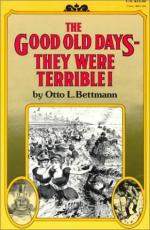|
This section contains 461 words (approx. 2 pages at 400 words per page) |

|
The Good Old Days--they Were Terrible! Summary & Study Guide Description
The Good Old Days--they Were Terrible! Summary & Study Guide includes comprehensive information and analysis to help you understand the book. This study guide contains the following sections:
This detailed literature summary also contains Topics for Discussion and a Free Quiz on The Good Old Days--they Were Terrible! by Otto Bettmann.
The Good Old Days - They Were Terrible! is archivist and historian's Otto Bettman lively romp through late 19th century America. Bettman intends to prove that this period of American history was not the idyllic "good old days" they have become in the minds of contemporary Americans. Bettman concentrates on several sections of everyday life, showing that reality does not paint nearly the same picture as the nostalgic imagination does. Focusing primarily on New York City and the working poor, Bettman demonstrates the injustice, filth, exploitation, poor housing conditions, and poor education that were standard in this period.
Rapid industrialization produced an unprecedented amount of air pollution. Industrial waste mixed with pig manure and garbage thrown in the streets to create an awful stench and unhealthy air. Massive amounts of horse-drawn streetcars packed people in like cattle and created gnarled traffic jams—not to mention the generation of massive amounts of manure. Primitive sanitation could not handle the massive amount of garbage produced by civilization.
Overpopulation resulted in cramped, dilapidated townhouses and tenements. Landlords, in absence of any renters' rights, charged exorbitant rents and engaged cruel evictions. The introduction of the apartment only served as a continuance of the problem, with the added tragedy that the vertically-oriented buildings, short of safety features, were deathtraps if a fire broke out.
The American worker was regarded as little more than another resource to be used up and tossed aside when exhausted. Workers worked 16-hour days for pittances in terms of wages. Dangerous workplace environments, such as the metal particle-filled air of the steel mill or the sawdust-filled air of the saw mill, caused severe health problems and deaths. Child, who would be worked just as hard and long as adults for less wages, were ruthlessly exploited.
Political machines controlled city governments, resulting in massive graft, corruption, and ineptitude at the local level. Bribery was common in the courts and in the ranks of the police force. Justice could be bought, and punishment and incarceration was brutally cruel, intended to punish rather than rehabilitate.
Fresh meat was a rarity, and grocers, bakers, and others would frequently adulterate their foods to increase profit, producing such favorites as "bogus butter," lethal candy, and "swill milk." Disease was poorly understood and ran rampant in both urban and rural communities. Doctors were little more than profit-hungry quacks, and hospitals little more than rat-infested poorhouses.
Education was farcical, featuring teachers without diplomas, thuggish students, corporal punishment, and teaching methods centered on mindless repetition rather than true learning.
Finally, travel via ocean liner, railroad, and ferry was a dangerous risk. Ferries were "floating bombs" with their corroded boilers, and the poor were stuffed below-decks in ocean liners while the rich relaxed in comfortable abodes above-deck.
Read more from the Study Guide
|
This section contains 461 words (approx. 2 pages at 400 words per page) |

|



